Garlic Mustard Info
About
 Garlic Mustard (Alliaria petiolata) is a rapidly seeding European plant sweeping southern Wisconsin. The plant was little known here 2 decades ago. It is reaching high proportions now. Deer and people are constantly spreading the seeds.
Garlic Mustard (Alliaria petiolata) is a rapidly seeding European plant sweeping southern Wisconsin. The plant was little known here 2 decades ago. It is reaching high proportions now. Deer and people are constantly spreading the seeds.
This website contains information on garlic mustard control, including dates relative to the seasons and ecology of Rock County, Wisconsin. The dates are for reference only. Always verify events in the field. This site presumes users are aware of garlic mustard and are searching for remedies. Managers that start control methods before or shortly after the onset of invasion may succeed, provided they are committed. Control after inundation becomes difficult. Citizens are advised to carefully study the section on garlic mustard Life Cycle as a prerequisite to control. Detailed knowledge of the life cycle will greatly aid all control methods. Links to Wisconsin Department of Natural Resources are helpful. Further links to garlic mustard websites are provided also.
Comments and suggestions are welcome at 608-757-5473 (Rock County Parks Community Coordinator).
Life Cycle
Seed dormancy
Garlic mustard is a biennial plant (lives two years). Seeds are dispersed at the end of the plant’s second year. Pods desiccate when mature plants die in late July or August. Seeds are tracked by animals, people, or are spread a short distance by wind. Seeds normally remain dormant 1½ years (20 months) but may endure seven years before sprouting or decomposing. Twenty months is the normal interval from seed dispersal, through one-year of dormancy, to spring germination. This duration is common and expected but may vary. Plants may germinate at odd times of the year.
April 1 - Seedlings emerge
Tiny mustard seedlings become visible in Rock County around April 1. At this date most (but not all) native flora is dormant. ‘Normal’ woods should appear drab and brown with decaying leaf litter. The snow may have recently melted, and more is possible. Below are garlic mustard seedlings in southern Rock County on April 8, 2007. The photo at right includes the characteristic adult (second year) plant enthusiastically resuming growth after a spring thaw. The acorn cap is about a dime in diameter.


Light scatterings of seedlings can be tricky to spot. Sometimes that is all we have to look for. More commonly, garlic mustard germinates in blankets and appears as low, light green moss. One would think a giant gardener was spilling seeds. Colonies become visible decorating the bare dirt (their favorite habitat) and freshly burned woods where the charred leaf litter adds contrast. For uncertain reasons, perhaps as the result of squirrels transporting seed in their fur, copious seedlings are often found at the base of large trees.
All embryonic plants have characteristic ‘baby’ or “seed leaves”. Garlic mustard belongs to that large group of plants called “dicots” that always sprout two seed leaves. Garlic mustard seed leaves last two or three weeks. They initiate growth, and then give way to regular leaves. Identification becomes certain at this stage because we can see the veins and margins that typifies the plant. Below, left, is a garlic mustard with regular leaves forming on April 20, 2007. To the right is a typical mass of mustard seedlings with small but regular leaves a week later, on April 27.

Rosettes
Sometime in May (while the second-year plants are distracting us with combat) first year seedlings take on their characteristic “basal rosette” appearance. Leaves grow in a whorl around the base of the plant. Basal means occurring at the base of the plant, and rosette means emanating from a single, usually central, point. Only basal leaves appear on first year plants, no flowering stalk. Mustard rosettes may contain two to a dozen leaves. The number and size will increase all summer. By the end of the fall, rosettes may have expanded to 15 inches across. Below are two images of rosettes. The photo at left is courtesy of WDNR. It shows a first year rosette in May or June. On the right is a rosette in December 2006. A ball point pen provides size reference.
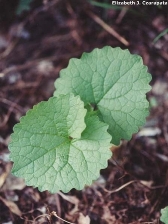
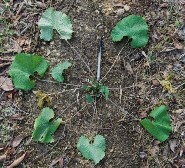
June December
Garlic mustard leaf venation
Garlic mustard leaves have distinctive veins that are slightly raised on the underside. They form a net pattern. The margins are always mildly toothed. Most people learn to spot these identifying patterns after a little practice. Here are two close-ups for reference.
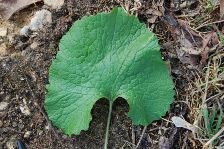
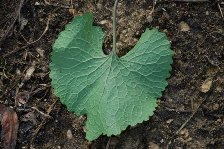
Top Bottom
Garlic mustard green in winter
The dormant season in Rock County is broadly November through April. Temperatures drop and hover around and often below freezing. Garlic mustard stays green some of this time. We often find it dark green under thin early snow or frost. It must grow very little during this period. Winter with no snow is a great time to scout for garlic mustard. It can be seen dark green just about anytime.
Native plants green in winter
Some native plants may be green in winter too. Their identification should be practiced so we don’t accidentally kill them when combating garlic mustard in the ‘dormant’ season. Native flora that may be green in winter includes mosses, grasses, sedges, and the basal leaves of some forbs (flowering plants). May 1- First (lowest) flowers in bloom
Garlic mustard produces flowers only in the second year of growth. Stalks rise from the basal rosettes in early spring. Leaves on the stalks are usually different from the basal leaves; they may be round but often appear more triangular. One to two-foot tall stalks will support clusters of fine, white, four-petaled flowers. The first flowers open about May 1. Many Rock County lookers notice garlic mustard the first time on May Day because this is the only tall white-flowering plant then. The flower clusters initially form somewhat flat or rounded-looking profiles like those seen in these photos. After this the stalks elongate. This causes the flowers to space upwards.
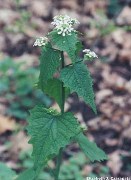

May 15 - First seeds formed and viable
The lowest flowers on the stalk are the first to bloom, and the first to turn into seedpods. Stick-like pods with viable seeds (ready to become the next generation) may be produced as soon as a week after flowering. Viable seedpods are usually common throughout Rock County by May 15. New flowers will continue to bloom, and form seedpods, as the stem elongates through May and June.
End of life cycle
Second year garlic mustard dies around mid-July. It may be one to four feet tall. Each plant will contain dozens of slender, stick-pods collectively holding hundreds of seeds. By August, most pods are drying and wind or creatures will disperse the seeds.
June: Almost done flowering & pods visible. / July: Pods are well-formed. / September: Dry pods & seeds falling.
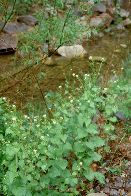
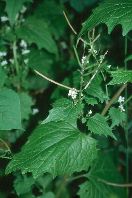
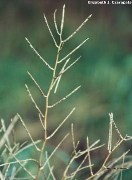
June July September
Height variation
Some garlic mustard plants never grow up. Compacted soils, inherited shortness, or other factors keep them spindly and low. These micro-mustards still bloom and produce seed, often under taller flora. They escape notice and eradication. Try not to miss them in your efforts.
Four pronouncements for controlling garlic mustard
1) All treatments must be aimed at reducing seed output. (Highest priority!)
2) All treatments should promote native flora.
3) All treatments should consider small-scale control (hand pulling of satellite infestations) and large-scale control (herbicide, string trimming, controlled burns). 4) Herbicide is strongly discouraged during the growing season because it kills native plants and creates more habitat for garlic mustard.
Local Control Programs
Rock County, Wisconsin, is largely agricultural. Fragments of land containing remnants of native plant communities such as prairies, wetlands, or woodlands were cataloged in a study called the Rock County Natural Area Survey 2002. Ecologist Robert Baller conducted the study on behalf of the Rock County Planning and Development Agency. Digital and print copies are available upon request at the Planning office (608-757-5591).
A number of hardwood remnants, both private and public, were found to still support abundant native wildflowers, and garlic mustard on the rise. Unfortunately most private owners are not controlling garlic mustard. Public institutions like Rock County, who would like to keep their parks in a natural condition, have only slender maintenance resources. It would seem the only hope for mustard-free lands is a few uncommonly devoted landowners, and some extremely well organized volunteers.
Garlic mustard is voluminous in Rock County and spreading exponentially. Once inundated, as so many woods are already, we do not know if recovery is possible. Very long-term changes include native woodland plants being swamped out by sheer numbers of mustard plants, and garlic mustard destroying beneficial fungi in soil that forest trees need to regenerate. It appears the few wooded locations actively maintained in a reduced-mustard state now will be what remains of the natural woodland flora in our county for all future generations.
Parks with Mustard Control Programs
Three (3) public parks are known to have garlic mustard control programs. The efforts are being embraced, and made possible by, energetic, local volunteers. The parks are: Carver-Roehl Park (County of Rock), Riverside Park - Devils Staircase (City of Janesville), Big Hill Memorial Park (City of Beloit).
A brief summary of each follows. We fervently encourage interested people to contact the local organizers (listed at the end) and join the good fight in these needy woods. If you know of other locations receiving attention and that have long-term commitment for survival, please write us and we will add them to our list.
Carver-Roehl Park
Carver-Roehl is second oldest Rock County park, acquired in 1950. The 52-acre park is located in southeastern Rock County, north of Clinton, at the northeast junction of Creek Rd. and Carvers Rock Rd. A small tributary called Spring Brook meanders southerly through it. The Spring Brook waters dapple elegant sun reflections on the shady limestone outcroppings, and the low cliffs harbor rare ferns and other plants. Skunk cabbage blooms prolifically in the bottoms in early March. Visitors revel in the fine oak/maple forest with abundant spring flora. The far southern tip of the park has an oak savanna awaiting restoration.
Beloit area volunteers continue to battle garlic mustard in a two areas (one area is south of the entrance road, west of the stream; area two is north of the park entrance, west of the stream) during the last decade. Rock County Parks has received several DNR County conservation Aid Grants in recent years to assist with the garlic mustard control. These grants have enabled the County to hire a private ecological restoration firm to apply herbicide on garlic mustard. The herbicide is applied early in the spring to minimize damage to native species. We have achieved excellent garlic mustard reduction so far.
Riverside Park – Devils Staircase
Riverside Park is a mile and a half stretch of sweeping shoreline along the west bank of the Rock River in the City of Janesville. An 18-hole golf course occupies the upper level or escarpment, and public picnic areas and playgrounds are on the flood-terrace below. "Devil's Staircase" is a 1900-era label referring to a ravine with natural stone plates that lead to the river in the northern part of the park.
Before Riverside Park was dedicated in early 1900's, some of the cliff was quarried. Forest cover was very thin in those days. The steep cliffs and relative lack of visitor travel have permitted the site to recover to a natural condition during the last century. The cool northern exposure has grown into a unique 'northern' forest in southern Wisconsin. Spring wildflowers on the slopes and cliffs are stunning. The 10-acre station is considered one of the finest examples of woodland flora remaining in Rock County. Garlic mustard is just finding its way in, especially from the golf course above.
In our era, "Devil's Staircase" has been reapplied to a three-quarter mile segment of the national Ice Age Trail that will traverse the cliffs and woodland. A crew of volunteers and expert professionals constructed the trail in summer 2007. The Ice Age Trail team has been joined by the well-established Friends of Riverside Park for stewardship activities in this area. With glad permission and support from Janesville Parks Department, both are exerting garlic mustard control in the woodland of the Devils Staircase.
Big Hill Memorial Park
Big Hill Memorial Park looms ninety feet above the west bank of the Rock River about four miles north of the City of Beloit. The 200-acre park is an outlier to the City limits, deeded to the City in 1925. The 'big hill' has about 100 acres of oak and maple woods, much of it with very fine spring flora, on terrain from rolling and steep to level. The park is environmentally fragile and deliberately not developed beyond picnic spaces, bathrooms, a small softball field, and a few shelters with playgrounds. The City of Beloit has conducted anti-mustard campaigns since botanist Victoria Nuzzo identified it there in 1989. (Ms. Nuzzo was preparing a Big Hill Master Plan for the City. She has since become a nationally recognized garlic mustard authority.) The mustard continues to thicken on some neighboring lands, while other neighbors vehemently combat their infestations. Each season volunteers and the City of Beloit Parks crew scout, herbicide, pull, string trim, and weed torch garlic mustard. In winter they cut up and remove deadwood to facilitate access to infested areas. A public library organization called Green Phoenix is coordinating the volunteers. Numerous school groups have done wondrous damage to the mustard. It hoped the Girl Scouts, who have a program center within Big Hill Park, will some day join the effort also.
Big Hill Park is the largest known, single block of woodland maintained in a reduced-mustard state in Rock County. Because of its size, it may unfortunately become of national significance in the near future after most other woodlands are inundated.
Contacts
Please contact the coordinators below to inquire how you may help.
Parks with Garlic Mustard Control Programs Map [pdf]
Carver-Roehl Park (County of Rock)
Rock County Parks Director - Lori Williams 608-757-5451 [email protected]
Friends of Carver-Roehl Park President - Mel Jones 608-676-5603 [email protected]
Riverside Park - Devils Staircase (City of Janesville)
Friends of Riverside Park President - Pam Van Brocklin 608-563-4454.
Rock County Chapter of Ice Age Trail Coordinator - Mike Guisleman 608-884-9272 [email protected]
Big Hill Memorial Park (City of Beloit)
Environmental Consultant - Rob Baller 608-368-0901 [email protected]
Green Phoenix Chair - Mary Beth Miller 608-313-9518
Beloit Parks Director - Brian Ramsey 608-364-2929 [email protected]
Small/Large Scale Control
Small Scale Control
Small scale control refers to treatments in areas the size of a few urban back yards (usually wooded back yards), or the redress in larger woodlands and shady fencerows with minimal infestations. These can be managed by one or several people, often without chemicals or power equipment. The principle technique is hand pulling. Remember, all dates offered below are for general reference. Always confirm with actual events in the field.
Hand pull second year plants only
Hand pulling is a treatment best reserved for second year plants. First year rosettes are generally small and difficult to extract and have no seed threat yet. The first pronouncement for controlling garlic mustard declares reducing seed output is our highest priority. This means destroying the plants that will bear seed (second year plants). If you have a small area and extra time, go ahead and pull first year plants. First year plants tend to break off and leave the roots in the ground; be ready to pull the same plants again in a month.
Hand pull where there is minimal mustard
Scouting and hand pulling second year plants is essential for preventing new or 'satellite' colonies from forming. This is why hand pulling, especially in larger woodlots, should always be done where there is minimal garlic mustard. It helps keep uninfected areas uninfected and saves time and effort in the future. Mobile, search-and-destroy people should rove the larger woods and spot small infestations and pull them.
Flagging
In woodlands with emerging infestations, flagging goes hand in hand with scouting and hand pulling garlic mustard. Wrap brightly colored forester's tape (flagging) onto nearby tree limbs and slender trunks. This helps others locate the infestation and check it later for stragglers, especially after the woods have thickened with leaves. Always look back and confirm your flagging with this in mind. Colored forester's tape is available at any hardware store. Some people prefer cloth tape to conventional plastic tape. Both are acceptable. Both will fade in about a year. Tape should be removed or replaced each year as conditions determine and if continuous monitoring becomes desirable.
April 25 - May 15 - Optimal window for hand pulling
The best period for hand pulling garlic mustard is normally between April 25 and May 15. The mustard should be conveniently sized to extract fully. Prior to this plants may be too small to grasp. After mid May, roots can be so well developed they are troublesome to extract without a crane. It depends on the soil type. It is best to get the roots, but breaking the entire plant off at the base is quite devastating on them too, provided plants have buds and/or flowers.
Frankenstein effect – pulled plants will not die
Garlic mustard is famous for surviving a few days after being pulled out of the ground. Some plants hang on long enough to form viable seeds even after they are pulled. Plants pulled or broken prior to May 15 can be left in the woods because there are usually no new seeds, and new seeds are not likely to form. If the root comes out, shake the dirt away to hasten drying. Hang plants up, away from the ground, such as in a jumbled fork of tree branches. This really helps them dry and die fast. It also notifies passersby of your garlic mustard control efforts. You may inspire assistance. Scattering plants widely across a sunny park road is another way to insure desiccation. Pulverized residue will be your reward a day later.
May 15 - July 15 Pulling after seed formation - Bag All Plants
If pulling or breaking garlic mustard after the onset of seed formation (after May 15), plants should be bagged, tied, and placed in dumpsters. Any plastic bag will do. Please do not leave seed-bearing plants in the woods. We generally discontinue pulling around July 15 because of summer heat and relative seed maturity, but some ruthless enthusiasts will snap off mustard stems with seed heads and bag them all the way into August. By the end of August the pods are probably dry and there is little to accomplish, except to help scatter seed.
Garlic Mustard Disposal
If you pull garlic mustard at your home and you are a resident of the City of Janesville, please bag the mustard in clear plastic bags, label it well and leave it on the curb for trash collection. Make sure that it is bagged separate from the normal waste and that it is labeled very well. As an invasive species, it is disposed of in the landfill, not at the compost site.
Large Scale Control
Large scale control refers to the redress of areas with huge, continuous, garlic mustard colonies. These areas usually have well established seed banks. Colonies may be of mixed age, but often appear as one generation. Colonies that appear mostly as second year plants are best combated with string trimmers during May. Colonies that appear mostly as first season rosettes are best combated with herbicide during the ‘dormant’ season. In addition to these two methods described below, please review the section on Small Scale Control for advice on hand removal. Hand removal of satellite infestations is an integral recommendation for any large scale control.
May 5 - May 12 Optimal window for string trimming
As a general guideline, April 25 - May 1 is when second-year plants are about to bloom in Rock County. Tight green flower heads are poised on top of stems everywhere, ready to turn white. These budding plants, or those with the first few white flowers, will not recover much when cut at this stage. Trimming plants close to the ground level at this period is an excellent strategy for anyone wanting to dramatically curtail an infestation. A great deal of potential mustard seed can be utterly eliminated with this technique. The timing must be precise. Cutting earlier (before budding) may leave enough energy in the plant to flower again, though producing much fewer blooms and seeds. Cutting later (midway through the flowering season or later) is helpful and strongly urged if you missed the optimal window, but as the season advances there is increased chance of dispersing some viable seeds. Once the plant has begun flowering you can cut for a week and not worry you are leaving new seeds on the ground. After that plants cut, broken, or snapped by hand should be raked up and bagged for removal from the woods. It will take but a week for the first seeds to form once flowering has begun. County-wide the blooming period will stretch from April 25 to at least the end of May. We really would like to mow the mustard down before the flowers are in full force, and before seeds start to develop.
Trimming tools
Garlic mustard can be cut with hand scythes, mowers, or anything that breaks off the plant low to the ground with a minimum of soil disturbance (disturbing the soil promotes mustard germination). The highly recommended tool for mass destruction is the power string trimmer (as opposed to blade trimmers or lawn mowers). String trimmers can cut down more mustard, faster, at this stage than most other tools or techniques. Many Rock County woods are cluttered with dead fall. String trimmers allow close cutting to logs or obstacles. Some muscular exertion is definitely required. Always wear a full-face shield, long legged and long sleeved clothing, and leather gloves. String trimmers splatter around a lot of plant juice, including poison ivy.
Poison ivy
Poison ivy is common and may be forming leaves (hard to spot) when you are string trimming. If you find yourself trimming in a poison ivy patch, leave it. Address the mustard later with herbicide. Wash any exposed skin with soap and water immediately. You have six hours before you die (just kidding). You have six hours before the oil bonds to your skin and the next day you will start to itch. The rash may last up to three weeks depending on exposure and sensitivity. Many people are naturally immune to poison ivy. Most will eventually become sensitive after repeated exposure. If you are so blessed, maintain your immunity by doing what the rest of us do: wear protective clothing and wash often.
Trimming native flora
When string trimming garlic mustard, other flora will be cut too. This is unavoidable. Chances are, cutting will have a short-term negative effect on desirable plants. Most native woodland plants are perennial and should re-sprout.
Herbicide
In general, herbicide should be applied to garlic mustard only when most native flora is dormant. In Rock County this would be November through March. One has to be prepared to run out and apply herbicide on a sunny, snowless day when temperatures are abnormally warm (>50° F) and winds are calm. These conditions are most likely to occur in March or November.
The recommended herbicide is 2% glyphosate (in water). The familiar brand is Roundup© by Monsanto. Always read the label and follow directions. Generic formulations are also available at forestry or landscaping supply agencies. Brightly colored dye added to the herbicide will help keep track of where you spray. Water-soluble dye is often available through forestry suppliers. The spraying unit can be hand-held or a backpack type. Keep the nozzle at a fine setting and the sprayer pumped to high pressure. A fine mist is ideal for this delicate and plentiful target. Low pressure produces big droplets and wastes herbicide. Garlic mustard likes to hide in leaf litter. Kick or rake leaves to fully expose the targets.
Herbicide targets
1) First year rosettes, November through March.
2) Newly germinated seedlings in very early April.
Herbicide victims in April should turn brown in a week. Spraying in winter will not change the color of most green plants until growth resumes in April.
If new seedlings emerge after treating areas, repeat the treatment about a week later. Please be judicious and spare as much non-target flora as possible. Watch especially for bloodroot (Sanguinaria canadensis) and hepatica (Anemone acutiloba). These are two of our earliest, native risers.
Clearing brush and debris
Persecuted mustard often takes refuge under fallen branches. It receives protection from tangled vines, prickly raspberries, or logs. Protective clutter of this sort keeps us from reaching the mustard. Clearing brush is an essential component of an overall eradication effort. Clear the brush only in winter to avoid damaging native flora and stirring up the soil. Stirring the soil always favors the garlic mustard.
Tasks include:
1) Removing fallen dead debris. 2) Cutting and piling brambles, prickly ash, gooseberry, European buckthorn or tartarian honeysuckle. 3) Painting all freshly cut stumps immediately with 20% glyphosate in water with dye.
Some deadwood is normal for woodlands. No need to clear it all. Pick up enough to enable addressing the infestations. Piles of brush tend to snuff out whatever lies under them, so try to pile where there is little native flora to start. Always check upwards, and pick a location that won’t scorch tree limbs if the pile is burned a winter or two later. If you elect not to burn (or remove) the pile, it will make a fine home for a red fox.
Burning
Prescribed burning (a.k.a. controlled or conservation burning) during the dormant season promotes native flora by exposing the soil for faster warm up and by scorching low shrubs resulting in higher light. This is true both in prairies and woodlands. Burns are helpful in that they make all plants emerging from the dark earth more visible. Be warned: burning woodlands temporarily promotes garlic mustard for the same reasons it promotes native flora. It opens the soil to more light. Burning is great to promote as much garlic mustard as possible, in order to kill as much as possible. It can be disastrous if there is no follow-through the next March or April with herbicide or mid May with pulling and trimming. Do not burn after April 25 in Rock County woodlands because there is too much native flora out. Burning may also damage populations of beneficial insects, reptiles, or amphibians. When considering burning your woodland, consult with experts about both wildlife and safety. Wisconsin DNR should be of assistance here. Feel free to contact Wildlife Biologist Brian Buenzow at the Janesville Service Center. The phone number is (608) 743-4832.
Please keep in mind that wildfire is potentially lethal. The heat of oak leaf litter can be enormous. Always burn under safe weather conditions and with a trained, responsible crew. Check with local fire departments for rules and regulations. Check with local fire departments for permission or permits first and then courteously notify the 911 non-emergency Dispatch prior to ignition. The 911 non-emergency dispatch number is (608) 757-2244.
Buffers
Garlic mustard will fill any suitable neighborhood to capacity right up to the treated area. Legions will breathe seeds onto the free zones. All Rock County woodlands are inviting to garlic mustard. It is advisable to take the mustard point of view, temporarily, and locate desirable and undesirable habitat. Identify conditions that promote and deny the invasion. Figure perimeter lands into your long-term plans. Work with neighbors to maintain or increase mustard-resistant landscapes. This is not a suggestion to clear away existing woodlands. It is a call to recognize that every parcel is part of a larger continuum, and to use your knowledge of garlic mustard ecology to define blocks that can be reasonably defended. Landscapes that deter mustard migration may be called ‘buffers’. These include lawns, agricultural fields such as corn, soybeans, alfalfa, or brome grass, prairie plantings, wetlands, rivers, roads, and parking lots. Beware of stream banks and fencerows. These often provide corridors for mustard to migrate through.
When woodlands go bad
In certain cases, utterly degraded sites like railroad rights-of-way (not those with prairie remnants), industrial fields, or aggressively logged woodlots have little or no native ground flora left. Abandoned agricultural fields often succeed into contemporary groves of box elder, black cherry, Siberian elm, or mulberry. These may have very little or no native ground flora. Such places are ideal breeding grounds for garlic mustard.
Consult someone knowledgeable about landscapes and plants. Be certain you have these conditions. It is possible to apply herbicide to kill abundant mustard and prevent the seed crop. But this will empty the stage and leave it open for more garlic mustard. Introducing competing seed is one possibility. The preferable route is to work toward changing the habitat. The site can be gradually converted to a different habitat that is less conducive to mustard. This may require the assistance of someone able to diagnose and devise treatments. The WDNR maintains a list of environmental consultants that may be of help.
Weed Torches
Propane torches are the newest weapons in the war against garlic mustard. Weed torches are not flame throwers, but steady, flame-producing devises. We have one season of experience with these so far, and the results look promising. Here is what we have found.
The Torch
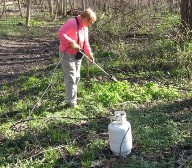 A propane weed torch generally consists of several feet of ½ or ¾-inch metal tubing, with a soup can-like “bell” at the end for directing flames. The torch is connected to a refillable propane tank, like those on backyard grills, via a length of rubber hose. Tanks of the 5 – 25 lb size are usually chosen. The gas flow and flame intensity is controlled by a regulator valve on the tube. Torches must be ignited with a sparker, never with a match in hand (we like our skin-hairs). Propane torch kits for killing weeds can be purchased at Menards or Farm & Fleet for about $50.00. Ten-pound propane cylinders (rechargeable, holding ten lbs of propane) are available at the same places or at hardware stores for around $40.00. Ten pound of propane gas costs $10.00-$12.00, depending on locality.
A propane weed torch generally consists of several feet of ½ or ¾-inch metal tubing, with a soup can-like “bell” at the end for directing flames. The torch is connected to a refillable propane tank, like those on backyard grills, via a length of rubber hose. Tanks of the 5 – 25 lb size are usually chosen. The gas flow and flame intensity is controlled by a regulator valve on the tube. Torches must be ignited with a sparker, never with a match in hand (we like our skin-hairs). Propane torch kits for killing weeds can be purchased at Menards or Farm & Fleet for about $50.00. Ten-pound propane cylinders (rechargeable, holding ten lbs of propane) are available at the same places or at hardware stores for around $40.00. Ten pound of propane gas costs $10.00-$12.00, depending on locality.
Larger cylinders are also available, but larger means more weight to haul through the woods. Ten pounds of gas in a 10-15 lb metal tank is enough weight already, and will last 4-6 hours of fairly continuous weed melting.
Concept
The basic idea is to cook the garlic mustard seedlings right after germination, before they - and the other plants - get bigger in spring. The window for this is roughly March 20 to April 20.
The flame duration required to ‘melt’ seedlings is miniscule. A one-second pass kills them instantly and completely. Often they emit a crackling snap as their tiny leaves wink out of existence.
Avoid second-year plants
Despite the temptation and immediate satisfaction of melting rosettes, we recommend avoiding second-year plants with the torch. Second-year plants have root reserve and will sprout again. Re-sprouted mustards have similar characteristics to cut-back shrubs: the stems are shorter, slimmer, more numerous, and trickier to find and pull because they become diffused among the other plants. They still flower and produce copious seed. For now we advise skipping the second year plants, and using the torch only on seedlings.
Native plants injured
Native plants may be injured by accident with this procedure. Hopefully, most are perennial and should have some root reserve to rise again.
Choose wet days
Torching can and should be done on wet, drizzly days, or on dewy mornings or damp evenings. Wet leaf litter may heat and smoke a little under the flame, but will not likely remain smoking. If there is any question about the conditions, have a bucket of water on hand. Better yet, get a backpack water sprayer like those used on controlled burns (Indian tank). Do not torch in the woods on dry days. Be especially wary around dead, dry, rotten logs. These can catch fire immediately and can be troublesome to put out.
Flame adjustments
Seedlings are killed rapidly enough with a moderate flame setting. Dialing up the flame to a more powerful, jet-like blast permits faster work and extends the reach of your sweep, but increases the possibility of setting something on fire not wanted. Use your good judgment and choose the flame level tying optimal performance with conditions.
Propane freezing
When flaming at high setting, weed torches may draw propane so fast they remove heat from the tank like an air conditioner. This is especially true after a refill, when the tank pressure is highest. The first thing that gets our attention is the flame diminishing. Then ice crystals may be noted on the tank, and can be heard swimming inside. The line will be very cold. The flow valve may be restricted. If this happens, turn the torch off a few minutes and rest. The problem usually clears itself up soon, and does not return once a little more propane has been used up.
Pros
1) Seedlings rightly fear the torch.
2) Great tools for destroying small (20 ft. diameter) localized, dense patches.
3) No herbicides or chemicals are used.
4) Minimizes non-target kill, the torch is very precise.
5) A good rainy day, cold season weapon, just when herbicide is impractical.
6) Excellent for an early jump on the infestation, heads off the population before anything rises.
Cons
1) Limited to seedlings only. Doubtful application for killing older plants.
2) No torching on dry days.
3) Seedlings can be difficult to spot and flame when mixed among other vegetation.
4) Must be applied in very early spring before seedlings get big and develop root reserve.
5) Can be burdensome to transport tanks long distances over steep terrain
Helpful hints
Pick dense patches and erase them with steady but brief sweeps of the torch. Try not to linger with the flame; this increases risk of lighting something you don’t want lit.
Erase the obvious colonies first.
When you have less mustard and much time, search and destroy the stragglers.
Carefully guard your hose from the flame.
Work in pairs. Extra eyes notice the mustard missed by the torcher. Extra eyes see smoke in the litter left a minute before. Extra hands helps transport the cylinders to the next patch, and keep the hose untangled, while the first hands are flaming. Working in pairs is highly recommended.
An aluminum backpack frame can be purchased or adapted to carry your propane cylinder. This enables transporting farther into the woods and on steeper slopes.
Smaller, five-pound cylinders are available. These are often associated with heating ice fishing shacks.

